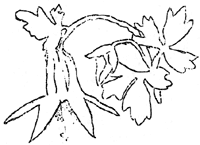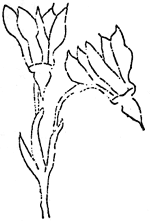|
Volume IV No. 1 - July, 1931
Flowers, Where The Scene-shifter - Nature - Is Always Busy
By Lincoln Constance
The casual visitor to Crater Lake is quite apt to be disappointed
when he fails to encounter the profusion of flowers which greet him at
Rainier or Yosemite. The light soil of the windswept Rim has not yet
put forth its full burden of vegetation, but even the intermittently
stormy weather has not prevented the alpine meadows near by from
producing a rainbow of color. This floral display is best exhibited in
the Castle Crest Gardens, Copeland Meadows and Munson Valley, but let us
visit the first, as the most representative and accessible.
On the open flat we encounter the Newberry's Knotweed (Polygonum
newberryi), conspicuous by its large oval leaves, jointed stem, and
greenish flowers. The brilliant yellow of the Sulfur Flower
(Eriogonum umbellatum), growing close to the ground, next
attracts the eye. Among the rocks at the side of the trail the Western
Anemone Windflower (Anemone occidentalis) rears it round,
feathery fruits. Just before reaching the meadows, the Wild
Bleeding-Heart or Dutchman's Breeches (Bicuculla formosa) and the
False Solomon's seal (Vagnera amplexicaulis) cooperate to form a
border of pink, white and green, and so enliven the trail.

The meadow itself is a giant's paint-pot, with dabs of all hues
lavishly scattered over it. At the upper end, the Blue Forget-me-not or
Beggar's Ticks (Lappula diffusa), the Mountain Valerian
(Valeriana sitchensis), and the blue of various Lupines
(Lupinus) dominate the scene. But as we continue, we note
splashes of various shades of red, the scarlet and yellow of the
Columbine (Aquilegia formosa), the gaudy crimson of the Indian
Paintbrushes (Casstilleja), and the rose-pink of the Lewis'
Monkey-flower (Mimulus lewisii), which is just commencing to
bloom. On the borders of the brook, itself, the pink spires of the
peculiarly-shaped Elephants' Heads or Butterfly-tongues (Pedicularis
greenlandica) mingle with the white clusters of the Alpine Smartweed
(Polygonum bistortoides), while the White Violet (Viola
blanda) and Alpine Buttercup (Ranunculua sp.) stud the green
carpet of grass and sedges.
Several shrubs stand out conspicuously from the herbaceous plant.
These include the Mountain Ash (Sorbus sitchensis), distinguished
by its masses of white flowers borne in flat-topped clusters from the
Red berried Elder (Sambucus racemosa), which bears its snowy
flowers in cones. The Pine Manzanita (Arcostaphylos nevadensis)
forms a mat in dry places, and is often supplemented by the Blue
Huckleberry (Vaccinium membranaceum), and occasionally by the
Matted Beard-tongue or Penstemon (Penstemon menziessi var.
davidsonii).

Less conspicuous but attractive flowers are the blue Alpine
Speedwell flowers, the Shooting-start (Dodecatheoum alpinum), and
two species of orchids -- the Slender Bog-orchid (Limnorchis
stricta) and the Boreal Bog-orchid (Limnorchis dilatata).
The large green leaves of the Green Hellebore (Veratrum viride),
and the young shoots of the Monkshood (Aconitum columbianum) and
the Ragweed (Senecio triangularis) make up an important element
of the herbage, but as yet are contributing few flowers.
We cross the bridge and again emerge upon the plain, where we are
greeted by the Alpine Puss-paws (Spraguea umbellata), the False
Alpine Dandelion (Agoseris alpestris), the Water-leaf or Pygmy
Phacelia (Phacelia heterophylla), the Newberry's Knotweed, which
form the main cover. Patches of yellow or orange are formed by the
Alpine Owl's Clover (Orthocarpus), and the yellow of the Sulfur
Flower again makes it appearance.
Colorful as the meadows now are, they give promise of even greater
beauty to be anticipated. Do not think you have "seen" the garden
because you have followed the trail to its end once. At every return
you will find it wearing a different aspect, for it is a changing
pageant of color presenting a new blended mosaic as only nature can mix
her color combinations.
More About Bugs
By Earl U. Homuth
In previous issues of Nature Notes appeared a series of
articles dealing with the efforts toward control and eradication of the
Mountain Pine Beetle (Dendroctonus monticolae, Hopk.) which had
attacked and threatened to destroy the pine forests of Crater Lake
National Park and the surrounding areas.
As mentioned in those articles, the beetle is destructive, due to
the fact that the larvae feed upon the cambium or living layer of the
tree, horizontally from chambers in which the eggs are laid by the
adult.
The solar method of control consists of felling the infested trees,
exposing them to the sun. A sun temperature of 85 degrees for a period
of one hour serves to destroy the eggs, larvae, pupae and immature
beetles in the tree. The trees are subsequently rolled half over, thus
exposing all surfaces.
Control work for a season must be completed or terminated by July 1
since by that time adult beetles emerge from the trees and subsequent
work would be useless. The work for this season covered the period from
April 30 to June 30. Due to a mild winter and early spring, and with
experience gained in previous years the work was more rapidly
advanced.
The number of trees treated this year totaled 14,747 over an area of
16,500 acres. This gives an average of .893 trees per acre. In 1930
the average was 2.2 and in 1929 it was 4.4 trees per acre.
When figures, covering the work of the past three seasons, are
studied, they prove enlightening.
In areas completely treated in 1929, the average decrease of
infestation in 1930 was 74 percent. The average decrease in 1931, over
86.1 percent.
In units incompletely treated the infestation showed an
increase, in one instance, of 59.5 percent in one year and in
another instance 82.8 percent in one year.
Observations in areas not treated indicate that the increase may run
from 50 to 200 percent.
It may be concluded from the complete figures on file that partial
or incomplete treatment is useless and that treating in areas subject to
reinfestation is also unsatisfactory. Only complete treatment of all
affected areas in one season will produce the desired results.
It may also be concluded that although the work has not been a
complete success, yet, had nothing been done, the pine forests of the
southern part of the park would present the same appearance of a "ghost
forest" as is found upon 33,000 acres in the northern portion.
It is also obvious that the present incomplete treating will
eventually eliminate all pine stands by cutting.
In conclusion it may be mentioned that the solar method of control
was developed in Crater Lake National Park and that progress and results
indicate that the method is successful, provided the treatment of all
infested areas is thorough and complete.
| 
